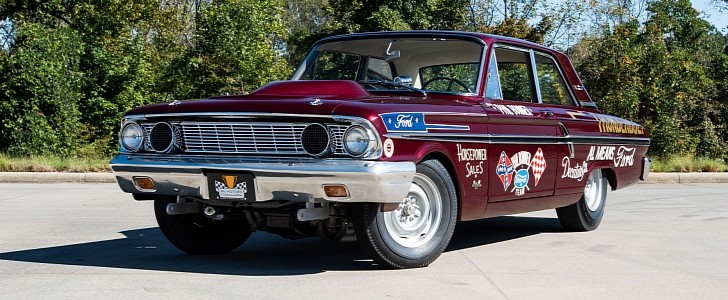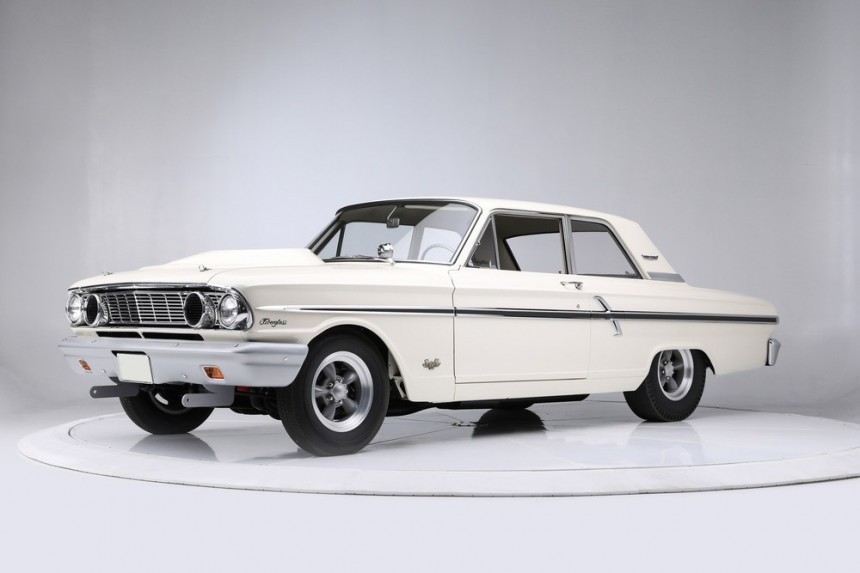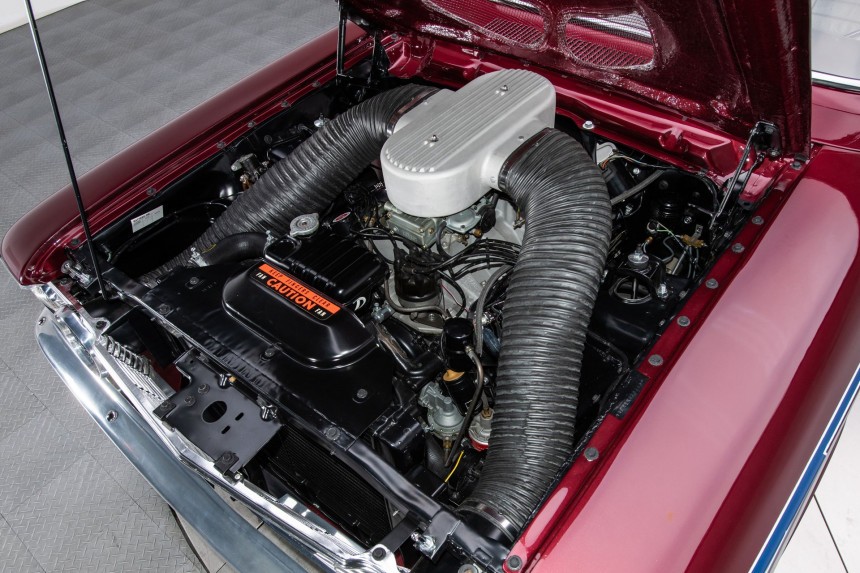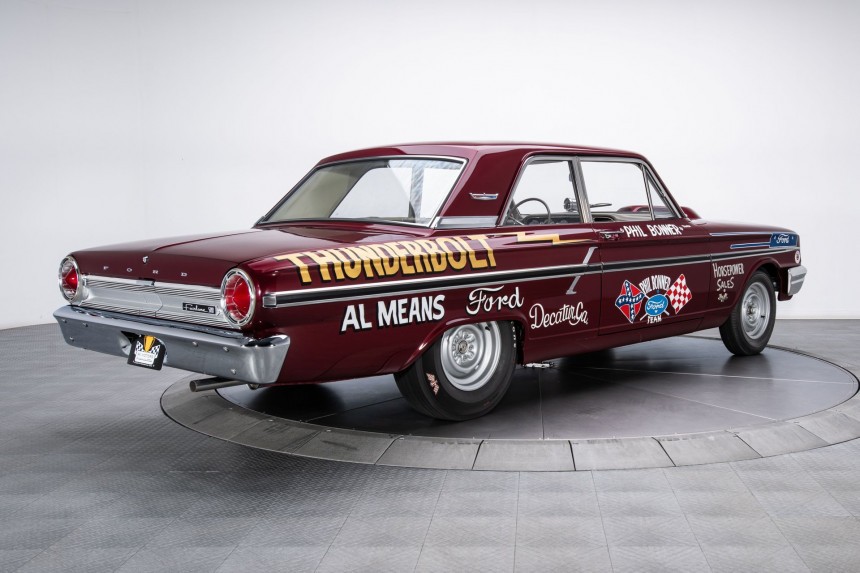It was the early 1960s, and Detroit automakers were taking the "win on Sunday, sell on Monday" motto seriously with massive involvement into drag racing. Chevrolet had the Impala Z11, Pontiac had the Catalina Super Duty, and Mopar had the Max Wedge engine.
Ford was betting on a lightweight Galaxie, but the full-size wasn't fast enough. So FoMoCo went ahead and created a new Super Stock dragster from scratch: the Thunderbolt.
Even though the lightweight version of the Galaxie proved competitive on closed circuits, it wasn't quite quick enough to win against the mighty Chevrolet Impala Z11 at the drag strip. Ford needed an even lighter car, and since the Galaxie was already as stripped down as it could be, the company started looking into different platforms.
Ford eventually went with the Fairlane, which had been redesigned into a midsize for the 1962 model year. At just under 3,000 pounds (1,361 kg), the fourth-gen Fairlane 500 was more than 600 pounds (272 kg) lighter than the Galaxie. To save even more weight, Ford took the lessons it learned while creating the lightweight Galaxie and applied them to the smaller Fairlane.
As a result, the Thunderbolt rolled off the assembly line devoid of sound-deadening material, seam sealer, heaters, and radios, while the fenders, hood, and decklid were made from fiberglass. Ford also replaced the stock steel bumpers with aluminum units.
Weight-saving surgery didn't stop here, though. The factory glass was swapped out of plexiglass panels, while the factory seats were removed to make way for almost flat buckets. These came from... wait for it... Econoline vans.
But prepping the Thunderbolt for drag duty wasn't all fun and games. Race-spec Galaxies used the massive, NASCAR-spec 427-cubic-inch (7.0-liter) V8, an engine that was too big for the fourth-gen Fairlane. The latter came with mills no larger than the 289-cubic-inch (4.7-liter) V8.
Ford's solution to this problem was to ship Fairlanes with the 289 Hi-Po option and fitted with the rock-solid nine-inch rear axle as standard, to the Dearborn Steel Tubing company for the Thunderbolt conversion.
To fit the 427 between the front fenders, DST engineers had to make quite a few modifications, starting with shaping the tubular headers around the front suspension components. Since the 427 V8 also had a high-rise intake, the hood had to be fitted with a tear-drop-shaped bulge, now one of Thunderbolt's most iconic visual features.
Finally, Ford replaced the inner, high-beam headlamps with massive scoops that fed air into the engine, giving the Thunderbolt's front fascia an even more intimidating look.
Once finished, the Fairlane Thunderbolt had 425 horsepower to brag about. But that was only on paper, as racers estimated an output that exceeded 500 horsepower. Weight-wise, the drag racer came in at just over 3,200 pounds (1,451 kg), which was the NHRA minimum for the Super Stock class.
Actually, the story goes that the Thunderbolt turned out to be too light for the category in the initial configuration, so Ford had to put one of the steel bumpers back on the car. That's why most Thunderbolts have steel bumpers in the rear and aluminum bumpers in the front.
Ford was able to put together the 50-car minimum to homologate the Thunderbolt for the 1964 season and went on to debut with a win at the Winternationals. The final was a Thunderbolt affair, with Gas Ronda defeating Butch Leal for the trophy. With quarter-mile times in the 11-second bracket, the Thunderbolt also went on to take the NHRA Top Stock crown that year, as well as the NHRA Manucturers' Cup.
FoMoCo ultimately built 100 Thunderbolts in 1964, 49 fitted with four-speed manuals and 51 equipped with three-speed Cruise-O-Matics.
While most of these cars survived years of hard racing and were eventually restored to factory specs, coming across a Thunderbolt is a rare occasion nowadays. And needless to say, they're far more expensive than the regular Fairlane 500, usually going under the hammer for more than $200,000. Quite fitting for one of Ford's most spectacular factory-built drag racers.
Even though the lightweight version of the Galaxie proved competitive on closed circuits, it wasn't quite quick enough to win against the mighty Chevrolet Impala Z11 at the drag strip. Ford needed an even lighter car, and since the Galaxie was already as stripped down as it could be, the company started looking into different platforms.
Ford eventually went with the Fairlane, which had been redesigned into a midsize for the 1962 model year. At just under 3,000 pounds (1,361 kg), the fourth-gen Fairlane 500 was more than 600 pounds (272 kg) lighter than the Galaxie. To save even more weight, Ford took the lessons it learned while creating the lightweight Galaxie and applied them to the smaller Fairlane.
As a result, the Thunderbolt rolled off the assembly line devoid of sound-deadening material, seam sealer, heaters, and radios, while the fenders, hood, and decklid were made from fiberglass. Ford also replaced the stock steel bumpers with aluminum units.
But prepping the Thunderbolt for drag duty wasn't all fun and games. Race-spec Galaxies used the massive, NASCAR-spec 427-cubic-inch (7.0-liter) V8, an engine that was too big for the fourth-gen Fairlane. The latter came with mills no larger than the 289-cubic-inch (4.7-liter) V8.
Ford's solution to this problem was to ship Fairlanes with the 289 Hi-Po option and fitted with the rock-solid nine-inch rear axle as standard, to the Dearborn Steel Tubing company for the Thunderbolt conversion.
To fit the 427 between the front fenders, DST engineers had to make quite a few modifications, starting with shaping the tubular headers around the front suspension components. Since the 427 V8 also had a high-rise intake, the hood had to be fitted with a tear-drop-shaped bulge, now one of Thunderbolt's most iconic visual features.
Once finished, the Fairlane Thunderbolt had 425 horsepower to brag about. But that was only on paper, as racers estimated an output that exceeded 500 horsepower. Weight-wise, the drag racer came in at just over 3,200 pounds (1,451 kg), which was the NHRA minimum for the Super Stock class.
Actually, the story goes that the Thunderbolt turned out to be too light for the category in the initial configuration, so Ford had to put one of the steel bumpers back on the car. That's why most Thunderbolts have steel bumpers in the rear and aluminum bumpers in the front.
Ford was able to put together the 50-car minimum to homologate the Thunderbolt for the 1964 season and went on to debut with a win at the Winternationals. The final was a Thunderbolt affair, with Gas Ronda defeating Butch Leal for the trophy. With quarter-mile times in the 11-second bracket, the Thunderbolt also went on to take the NHRA Top Stock crown that year, as well as the NHRA Manucturers' Cup.
While most of these cars survived years of hard racing and were eventually restored to factory specs, coming across a Thunderbolt is a rare occasion nowadays. And needless to say, they're far more expensive than the regular Fairlane 500, usually going under the hammer for more than $200,000. Quite fitting for one of Ford's most spectacular factory-built drag racers.





















